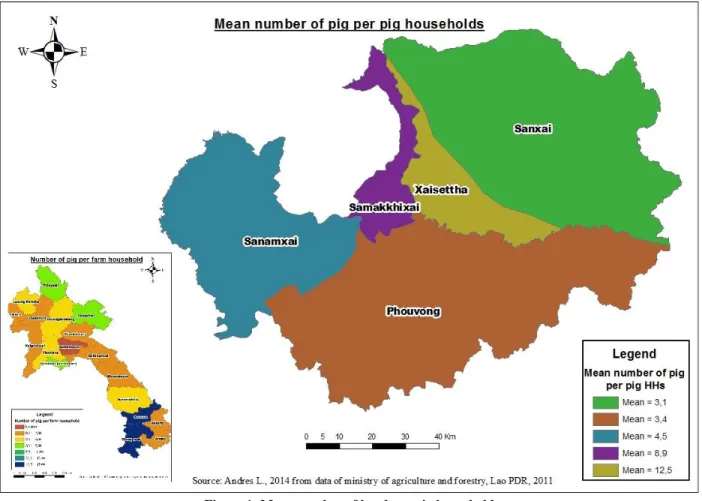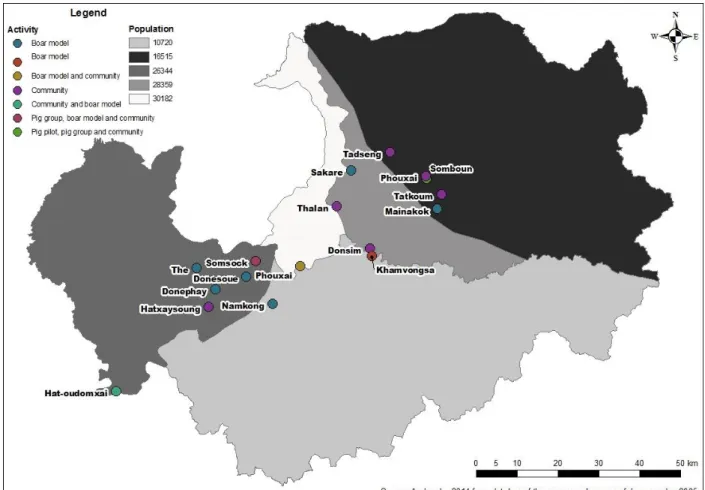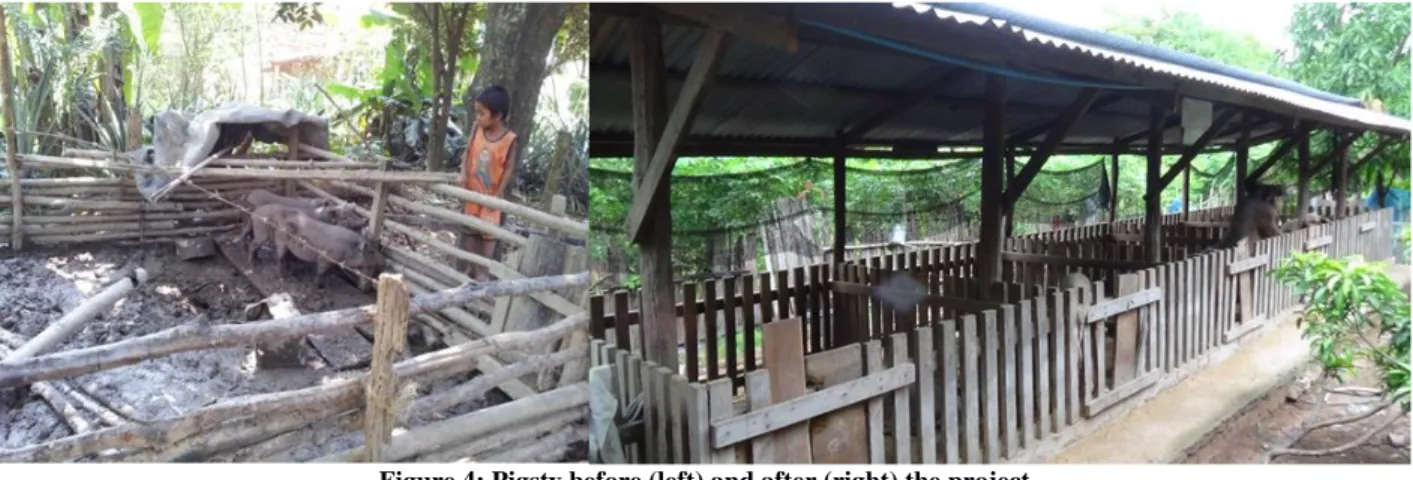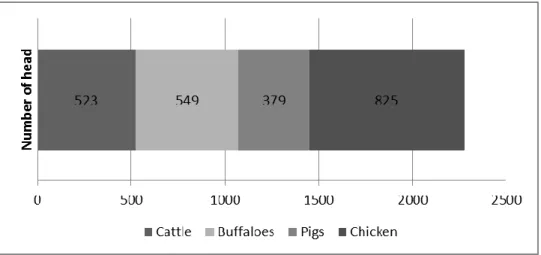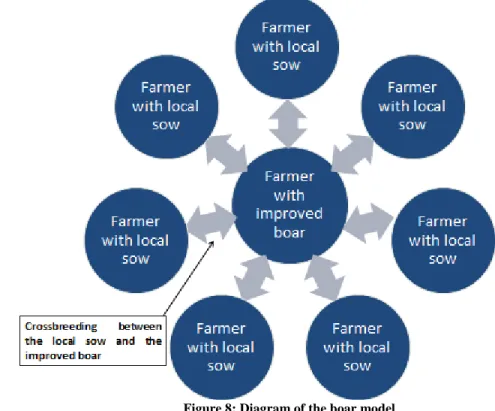Technical report of pig activities in Attapeu Lao
PDR
Final document October 2014
Promoting appropriate technology for smallholders to increase food security among peoples in Cambodia and Lao PDR funded by the European Union (Europaid) under its Technology Transfer for Food Security in Asia (TTFSA) Programme, and implemented by Université Libre de Bruxelles (ULB) in partnership with the Cambodian Center for Study and Development in Agriculture (CEDAC); Gembloux Agro-Bio Tech/ULg (GxABT/ULg) and Hanoi University of Agriculture (HUA) in the provinces of Attapeu (Lao PDR) and Ratanakiri (Cambodia).
« Promoting appropriate technology for smallholders to increase food security among peoples in Cambodia and Lao PDR » DCI-FOOD/2011/277-743
It shall be stated that the author is solely responsible for content communicated, published or disseminated and that it does not represent the European Union opinion (Europaid).
Technical report of the pig activities
1 Context and introduction
In 2011, the pig production in Attapeu province is estimated at 18,289 head of pigs. The Sanamxay and Saysetha districts contribute respectively to 25.10% and 24.51%. The share of households with pigs represents approximatively 50% of the households in Attapeu. Figure 1 shows the mean number of pigs per pig household. This mean number of pigs in Saysetha is higher than in the other districts of Attapeu. This mean amounts to 12.5 heads. The districts of Sanxay and Phouvong are lower with respectively 3.1 and 3.4 head per pig household (Figure 1).
Figure 1: Mean number of head per pig household
The pig production is characterized by an extensive system with free ranging. This system presents a low performance and low productivity. The knowledge of the households is reduced with respect to disease, medicine, vaccine, feeding and infrastructure (non-permanent stable). Most pigs are a local breed which has existed for a long time, with small volume, slow growth.
So, productivity and economic efficiency are very low. Nowadays, Attapeu initiates some pig farms which raise exotic and hybrid pig breeds from Vietnam or Thailand. However, almost all these farms were set up by the projects and are new establishments which lack experience. So, productivity and efficiency are still low. On the other hand, small-scale pig farm-households often buy piglets (crossbreed pigs) from Vietnamese traders, in raising process; farmers choose reproductive sows from fattened pig herds. In fact, the pig production in the households often uses by-products and leftovers from life activities, so pigs are small and have a slow growth. The feeding of pigs is based on the natural plants (banana tree, wild vegetable) and the by-products of rice (rice bran). Few households buy “industrial” feed. According to the Survey of March 2012, the province has 5 pig farms with industrial scale in Sanamkkhixay, Saysetha and Sanamxay which were set up by IFAD and ADB.
The pig breeding of the small farms is largely produced for self-consumption (celebrations, festivals and some parties), the village consumption and the local market. The farmers sell pigs to get money when it is necessary for them. The growth duration of fattened pigs is about more than 1 year, the farmers sell pigs by estimating the volume. Each pig gives the farmer 600,000 – 1,200,000 kips depending on the looks and the size. But the commercialization network isn’t structured and the network is characterized by few actors: some retailers and two or three wholesalers.
2 Pig activities
There are three types of pig activities: pig pilot, pig group and boar model. The pig pilot is a significant model of pig production in order to attract other households in learning. We have expanded production and spread/distributed improved piglets to other poor farmers in target villages of the project. The pig model is located in Somboun (Sanxay). The pig production is characterized by a local breed with a small volume and a low growth. The use of hybrid boar mated with local sows can improve the productivity and the number of piglets per litter. The pig group is the same system as the pig model but it is smaller and each pig group has just one improved boar. We have created two pig groups in the villages of Somboun (Sanxay) and Somsock (Sanamxay). Finally, the third activity is based on an implementation of improved boars in a group of households of a village. This boar is introduced in a beneficiary household and it is available for the other members of the group in order to realize cross-breeding and improve the
productivity of the piglets (Figure 2). The Annex 1 shows the distribution of pig activities in 17 target villages. The community’s activity represents the distribution of piglets. The piglets come from the pig model and pig group. This activity serves to spread the improved head of pigs in other target villages.
Figure 2: Localization of the pig activities in Attapeu
The project improved the following factors:
Permanent stable (supply the nails, the sheet metal, cement and sand);
Propose new feeds (banana, taro, sifted rice bran, few industrial feed);
Disease (diagnosis, treatment and vaccination);
2.1 Pig model
2.1.1 Localization of the model farm
The ANNADYA project has created one model pig farm. This model serves to distribute the improved head of pigs and to show the good practices for the pig breeding. The name of the head of the household is Thongvanh Yuanggyayia and the model is located in Somboun in Sanxay. The localization is chosen to raise/increase the pig production in the village and to support the development. It will be a significant model of pig production in order to attract other households to learn the good practices of the pig production. Then we will expand and spread out to a lot of other poor farm households in the village and in the Sanxay district.
Somboun is about 1 km from the North of center Sanxay district. In March 2013, it was one of the 39 poor villages in Sanxay district. According to the head of the village, the village is composed of 939 people (among which 470 women). 184 families live in 183 households and the number of poor households amounts to 45 families. The ethnic groups are Talieng, Alak, Se, Lao Lune, Oy. The paddy field is estimated at 58.90 hectares, that is 36% of the total agricultural land area. The rice productivity is very low, 1.5 tons per ha in the wet season and 2.0 tons per ha during the dry season. Besides, fruit trees and industrial tree plantations amount to 17.66 ha. The livestock farms are run by small-scale households, with extensive system without stables. The head of the village emphasizes the reduction of the number of head of cattle in recent years. The causes of this reduction are the epidemics, especially for poultry in January and February 2012 (Figure 3). The livestock market is more important in Somboun because the village has a permanent market and the road accessibility is better than in the other villages of the district.
66% of the households produce pigs at a small scale and with short investment. Most households produce 2-10 local pigs per year. This system is characterized by long periods to produce pigs (10-12 months), the lack of vaccination, the slow growth and the use of by-products to feed the pigs. The lack of cash flow induces a poor investment in the livestock.
2.1.2 Pig model
Mister Thongvanh Yuanggyayia is a Talieng and the number of members in the household totals four with two daughters and one wife. The workforce is estimated at three people but the young daughter also works during the holidays. The main economic activity of the household (in descending order of importance) is the livestock (pig, chicken and duck), rice transformation, forestry land (1 hectare) and gardening and fruit tree production. Before the project, the household had two hectares (ha) of rice but after the project, they rent the rice field. The rice transformation is realized with a rice huller. The payment for this activity is in kind. Indeed, they receive rice bran and rice in exchange for the service (rice transformation with huller). The garden is 400 square meters (m²) big and it has five mango trees. The production of gardening and of fruit trees is sold at the market. The fruit sale amounts to 1 million LAK and the price of three fruits is 5,000 LAK. The number of fruit is estimated at 67 fruits per year per tree. The main activity of the wife is the pig production but sometime she works for the other activities (gardening, fruit, and chicken). The husband only works for the livestock production and the gardening is done by the women of the household.
The project of ANNADYA supports the creation of the stable and the purchase of improved sow and boar. The purchase of sow and boar is realized by the project (50%) and the farmers (50%). Furthermore, the project supports the purchase of the piglets’ feed. The contract with the beneficiary household is based on the return of forty pigs for other poor beneficiaries. Furthermore, this model is used to improve the knowledge of the household and to serve as a model for the other poor households of the village and for other villages. Before the project, they raised 19 pigs (one boar, two sows and 16 piglets). The cost of the project is estimated at 2,102 euros. The most important cost is not the local and improved pig but the cost of “technical” assistance (pigsty, vaccine and industrial feed). The household has received ten sows but it pays 50% of this support and two sows are selected in the old litter of 2012. The cost of the pigsty is
divided up between three stables and the dimensions of these stables are: 12 m by 2.5 m; 6 m by 1.8 m; 6 m by 2.2 m.
The benefits of this activity include:
Refund of 40 piglets for other poor households (in 2014, he refund only 19 piglets);
Supplying and disseminating of about 30 sub-reproductive sows and 60 piglets per year to other households;
Supplying pork’s meat to the local market;
Increasing the income of the household by breeding development;
Disseminating the good practice for the pig breeding (cross-exchange activity).
The pigsty is built on 64 square meters (m²) and the one below was designed for 10 sows and 15 piglets per cycle (Figure 4).
Figure 4: Pigsty before (left) and after (right) the project
According to the survey realized in September 2014, the project has introduced improved animal in the household and in the village but even more important, the project has changed the technique/methods of the household. Before the project, the household didn’t cut the umbilical cord after the birth, the boar wasn’t castrated early and the medicines and vaccines were very poor. After the project, the number of piglets per litter has increased. It has passed from 5 piglets per litter to 8 piglets per litter. The number of working hours per day per person has increased to 5 hours and three people work for the pig production. But in 2014, the household doesn’t work for the rice production anymore. According to the agricultural census of 2011 of the ministry of agriculture and forestry, more time was devoted to the rice production than to any other
agricultural and livestock activities. The mortality per year has decreased thanks to the introduction of the good practices concerning medicine and vaccine (Table 1).
Table 1: Comparison and impact of the project
Before (2011)
After (2013)
Number of piglets per litter 5 8 Number of working hours per day per person 2 5 Number of labour force 1 3 Number of dead pigs per year 50 30
Compared with 2011, the main changes concern the feeding and the medicine. The feeding before the project was based on the rice bran production and the vegetables of the garden and after the project, the household uses the rice by-products (rice bran) (50%), the vegetables (30%) and the industrial feed (20%). The vegetables come from the garden (their garden and the neighbors), the forest and the market. The improvement of the feeding is possible because the household has the capacity to produce a lot of rice by-products. Furthermore, the rice product is better used with a fine ground. The household knows better how to use the medicines and vaccines. Before the project, they didn’t use the vaccines and didn’t identify the animal diseases and the medicines or vaccines that should be used. The castration is another good practice introduced in the pig breed. As a reminder, the castration increases the quality of the pig meat. In addition to this improvement, the other main result is the production and the dissemination of improved pigs in the village of Somboun and in the other village of Sanxay.
Before the project, the pig activity presented some benefits (2,499,333 kip) but the cost of pig production was rising with the depreciation of the stable (31%), pig purchase depreciation (22%), the veterinary care (18%) and the feed, purchase of rice bran (29%). The depreciation of the stable was estimated according to its lifetime estimation (5 years). The cost of pig purchase was obtained by the sum of the price given for the piglets’ purchase and the depreciation of the sows and boar. Finally, the sale was estimated with the local sow price (800,000 kip/sow), the boar price (1,500,000 kip/boar), the piglet price (150,000 kip/piglet) (Figure 5). In 2011, the piglet production amounted to 16 and the sale was located in four villages: Vangxai, Mixay, Mainakog, and Phouxai. The pig production was composed of 2 sows, one boar and 16 piglets.
Figure 5: Estimation of the pig profitability before the project
After the project, the household had twelve sows, three boars and 128 piglets in 2013. The household sold two sows, one boar and 55 piglets. The other piglets were selected for the pig group of Somboun (6) and the other poor beneficiaries of the project (13). In addition, the household kept 24 for the next year. The other piglets died during the year. The pig purchase was higher than in 2011 because the household and the project bought 10 sows and one improved boar. The household paid only 50% of the pig purchase. The depreciation of the stable was estimated according to its lifetime (10 years) and the total price (Figure 6). But the pig’s benefit will increase in 2014 and 2015 because the pig purchase cost decreases and the distribution of 40 piglets is closed.
Figure 6: Estimation of the pig profitability after the project
Price per year Pig purchase LAK 426.667
Veterinary care LAK 350.000
Feed LAK 574.000
Stable LAK 600.000
Total cost LAK 1.950.667
Sale LAK 4.450.000
Benefit LAK 2.499.333
Price per year Pig purchase LAK 2.625.000
Veterinary care LAK 1.000.000
Feed LAK 5.521.950
Stable LAK 1.800.000
Total cost LAK 10.946.950
Sale LAK 18.750.000
The cost per pig is slightly higher than the cost before the project. The average cost per pig after the project amounts to 250,000 against 175,000 LAK in 2011. The household’s benefit increases to 212%. Furthermore, the sale is located in 10 villages and the household has three or four regular buyers.
2.1.3 Outputs of the pig model
After the survey in September and the monitoring during two years, the outputs of the model pig farm include:
Better technical practices concerning feeding;
Better medicine and vaccine management;
Growth of pig’s income ;
Growth of the protein diet;
Better dissemination of these practices;
Better pigsty to fight humidity, better waste management and animal production
The dissemination is realized through a cross-exchange. Indeed, in September 2014, the pig farm households of Somboun benefited from a cross-exchange in the pig model. The model farmer has explained the good practices of a pig production (pigsty, feeding and disease treatments). The ANNADYA team has brought some additional information. This activity is very important to make sustainable development. Indeed, the farmers are more understand better if another farmer explains the good practices. In 2013, the project organized a visit during the veterinary training course for the 71 veterinarians of Sanamxay and Saysetha.
2.2 Pig group
According to the survey of 2012, the pig production in Attapeu has many problems:
The pig production; the pigs of Attapeu are characterized by a local breed with small volume and low growth;
The pigsty is essentially a temporary housing;
The pigs’ feed based on locally produced feed resources such as rice bran and by-products from agricultural production.
No vaccination is realized; so many pigs died in 2009. The main diseases are Cholera, Pasteurellosis, and FMD.
Lack of technique for treatment, feeding, pigsty
These problems should be resolved with the introduction of the pig groups in two villages: Somsock in Sanamxay and Somboun in Sanxay. The beneficiary households are chosen to improve the pig production and to disseminate the better practices for pig production. In addition to the two pig groups, 30 piglets were given to other beneficiary households.
2.2.1 Localization of the pig group
The first pig group is located at the same village of the pig pilot. The project developed a pig group with three households of Somboun. The second pig group is located at Somsock in the Sanamxay District. The distance between Somsock and Attapeu is approximatively 35 km. but the road is bad, especially during the raining season. In 2012, the village was composed by 312 households with 1,653 people (48.27% of women) and 83 poor households. The ethnic minorities are the Oy and Lao Kinh. The agriculture is mainly based on the rice paddy production. The paddy area was represented 5,921 ha and this area occupied 1/3 of the natural area. But the farmers present a lack of irrigation system. This lack increases the variability of the rice yield and causes a differentiation between the wet and dry season. The rice’s yield attempts to 1.5 and 2.0 tons per hectare. During the dry season, the household grows vegetable for their auto-consumption. According to the survey in 2012, the livestock amounts 2,276 heads. The chickens were the most important production in Somsock. The pig’s production was estimated to 379 heads (Figure 7).
However, the number of animal’s head was decreased in 2011 because the epidemics (FMD and Pasteurellosis) were decreased to 10% the livestock. The livestock is produced in small scale with local breed, low growth and productivity. The time of breeding is very long and the weight is lower than the improved head. In addition to, the veterinary capacity is very limited in Somsock. The project identified ten beneficiary households (Table 2).
Table 2: Information of the beneficiary households at Somsock Source: Survey Data, 27 Sep. 2012; x: depend on project
No Household’s name M em b er Wor k for ce Nb of pig Pad d y lan d (ha)
Support request by project
S ow Pig B oar Pigsty ( m 2 ) Fe ed T ec h . an d vac cin e 1 Mr Bounsavanh 5 2 2 8 2 01 20 x x 2 Mrs Y pan 4 2 2 10 2 20 x x 3 Mr Chandon 7 4 2 3 20 x x 4 Mr Kongvan 8 4 3 8 3 20 x x 5 Mr Merloun 4 2 2 1 20 x x 6 Mr KanDeua 9 2 4 5 3,5 20 x x 7 Mr Bounthat 6 2 1 3 2 20 x x 8 Mr Sanye 5 2 2 20 x x 9 Mr Sompin 7 4 2 5 3 20 x x 10 Samay 5 2 2 4 2 20 x x 2.2.2 Pig group
In September 2014, the survey realized an analysis of the pig production of Somboun. The pig group household is composed of three members. The survey is realized in the household of Mr.Ny. The husband and the wife constitute the main workforce. But sometimes the daughter works for the pig production and the household’s store. The household has a rice field of one
hectare and the production is estimated at 2 tons. The other economic activities of the household are the pig production and a store. The household has received one sow by ANNADYA project.
The monitoring of this activity has demonstrated an improvement of the pigsty. The household didn’t have a pigsty before the project. The other improvements concern feed and the treatment of diseases. Before the project, the feeding was only composed of rice bran. But after the project, the household uses the rice bran, some vegetables (banana, taro) and to a lesser extent some industrial feed. The industrial feed is bought in Saysetha. Saysetha district presents the biggest/highest density of pigs per pig farm household (Figure 1). The number of working hours has increased after the project. The working time goes from 1.5 hours to 2.5 hours per day per worker (Table 3).
Table 3: Some characteristics of Somboun pig group
Characteristics of pig group Before the project After the project
Number of working hour per day 1,5 2,5
Number of work force 1 3
Number of piglets per litter 5 8
Feed Rice bran Rice bran, vegetable, industrial feed
Improved breed No Yes
Treatment and vaccine No Yes
The Somsock pig group presents a very good result. The number of piglet per litter increased until 10 piglets. The following of the ANNADYA team decreased the pig diseases by the increase of the animal’s diagnostic and the application of some treatment. These diagnostic and treatment are realized with the farmers to increase their animal’s knowledge.
2.3 Boar model
The boar model was introduced in some households. One household per village is chosen to receive an improved boar. This boar is used to realize crossings with the sows of the beneficiary households. The boar groups are located in ten target villages: Sakare, Donephay, “The”, Hadoudomxay, Donesoue, Somsock, Kamvongsa, Namkong, Phouxay (Phouvong), Mainakog. The main result of this activity is the genetic improvement of the pig production. The boar model of Hadoudomxay and Phouxai stop after one year because this activity isn’t possible. In Hadoudomxay, the boar model is stopped because the flooding of 2013 caused poor rice’s
yields. The household sold all pigs to provide the food consumption. The boar has been sold by the project. In Phouxay, the advantage to use a boar and to improve the productivity do not been explain by the boar’s farmer with the other household. In fact, the boar’s farmer is used to disseminate the advantage of the crossbreeding between the improved boar and local sow. Obviously, exchanges between households depend on the implication of their. The figure 9 shows the diagram of the crossbreeding between the pig’s producers. These producers have the local sows and the project introduces an improved boar in a farmer. This farmer disseminates the best practices for the pig’s production. The boar’s farmers received an improved boar, vaccination and disease treatments. For example, the farmer of Kamvongsa disseminated with the team the increase of rice bran sifting, the disease’s diagnostic. It should be noted that the farmer call the team if he has some problem (disease, epidemic, crossbreeding). The boar model presents a high involvement of the farmers (Figure 8). For each crossbreeding, the boar’s farmer receives 50,000 kip to supply boar feed. The local sow’s farmer receives 20,000 kip to encourage the crossbreeding with the improved boar.
Figure 8: Diagram of the boar model
3 Benefit and sustainable improvement
By July 2014, the activities had improved the genetic capacity of pigs in 194 households. The project has produced 1,287 improved-breed head in 17 villages. According to the ministry of agriculture and forestry, the improved breeds are estimated at 4.15 % of the total. The genetic improvement is showed in the Annex 2. During the project, the mortality rate is very low and estimated to 11%.
66 weight measures are realized in different villages to compare the performance. These measures were realized during the project. Figure 9 shows the difference between the local pig growth and the improved pig growth. These measures have increased during the monitoring of the project in October and November 2014. The improved pigs have a higher weight than the local improved. In addition to, the weight of local piglets presents a high variability (Figure 10).
Figure 9: Comparison of the local and improved pig weight
The improvement of the technique is realized thanks to the feeding. Indeed, many households use the rice bran to feed the pigs. But this rice bran wasn’t sifted before the project and the level of intake was very bad. Currently, the households sift the rice bran before feeding the pigs. Furthermore, after the project, the households feed the pigs with by-products of
vegetables (banana, tarot and others). Finally, the industrial feed is used to increase the protein diet of the pig. The ANNADYA team is available to answer questions about diseases. Indeed, some households call the team to help them. The team identifies the disease and treats it with the farmer. The project builds a new pigsty with the farmers to fight humidity, to protect from the rain and to prevent diseases (Figure 5).
The main problems of the pig’s production in Attapeu are the disease diagnostic and the treatment’s access. These problems are resolved to increase the veterinarian’s capacity and the treatment access. The network with the medicine’s store and the veterinarian will be increased to struggle against these major problems. In addition to, the trade network is not structured and the market’s access is not easy for the vulnerable farmers.
4 Annex
4.1 Distribution of the pig activities in the target village
District Village Activities
Sanxay
Tatkoom Community
Phouxay Community
Tadseng Community
Somboun Pig model, pig group and community
Mainakog Boar model
Saysetha
Sakare Boar model
Donesim Boar model
Thalan Boar model
Sanamxay
Somsock Pig group, boar model and community
Hadsaisoug Community
Hadoudomxay Boar model and community
Donephay Boar model
The Boar model
Donesoue Boar model
Phouvong
Kamvongsa Boar model
Phouxay Boar model and community
4.2 Illustration of the pig crossing
4.2.1 Pig pilot
F1(L×Y) boar improved sow
4.2.2 Pig group
F1(L×Y) boar Local sow
4.2.3 Boar model
F1(L×Y) boar Local sow (Moo Lat)
4.2.4 Local crossbreeding
Local boar × Local sow
Local boar Local sow
